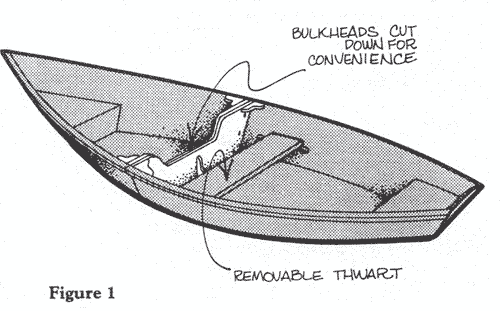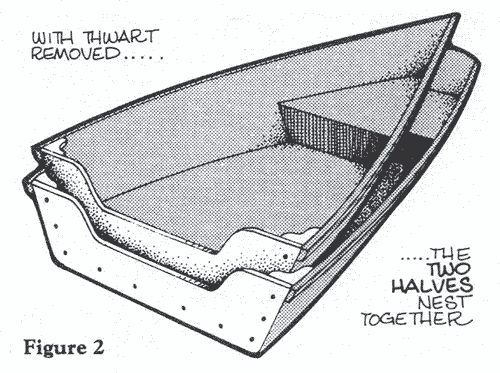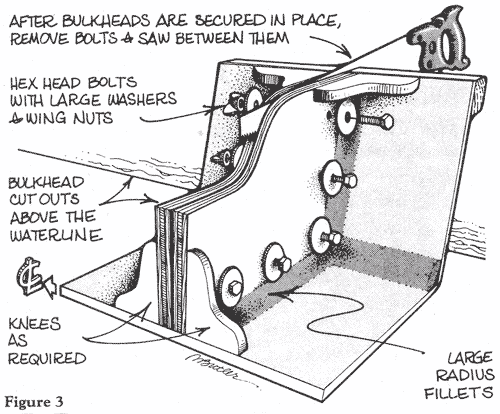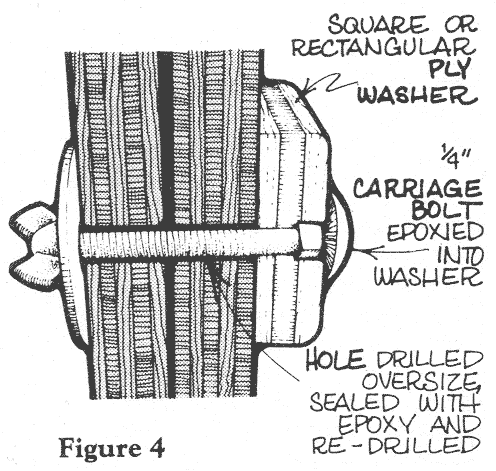Two (or three) Part Boat
Space-saving Alternatives to a Single Hull
by Paul Butler
illustrations by Marya Butler
Ever try to fit an 8-foot dinghy onto a 7-foot foredeck? Lift a rowboat onto the top of the family station wagon? Squeeze a 16-foot rowing dory into the back of an 8-foot truck bed? Prams, dories, and rowboats, small as they are, are often subject to severe space restrictions like these, and trailers are usually more trouble than they're worth. But there is an option for owners of plywood, cold-
molded, and fiberglass boats.
By using epoxy and plywood, it is possible to install back-to-back watertight bulkheads in a small hull, which, by removing a few fastenings, can be easily and quickly taken apart and reassembled. Bolted together, the bulkheads function as watertight dividers, and they stiffen and strengthen the hull. Unfastened, the sections can be carried or lifted more easily than a single hull, and they will fit into a smaller space. One section may even
nest inside the other.

The efficiency and sealing ability of epoxy is what makes this operation viable. But it needs a dry, tight hull to work best and is not recommended for traditional lapstrake hulls or hulls with aging chine logs and keels that weep constantly.
Strategic Planning
Because hull types and individual requirements differ, give some thought to exactly where the bulkheads should be placed, lf you locate them precisely in the center of the hull, one half won't fit inside the other. If nesting is a priority, do some measuring to ensure that the smaller half fits inside the larger. Since bulkheads can go almost anywhere in the hull, it's possible to arrange for a specific use or to fit a specific location, like the cabin top of a larger boat or back of the family wagon. Use as many bulkheads as are necessary to accomplish the objective.
Preparing to Epoxy
With small boats, it's usually easiest to make a cardboard or thin plywood pattern of the bulkheads and then have a good long look at the pattern in place to see if there will be conflicts or problems. The top of the bulkhead can be cut away if it interferes with seating, rowing, or sailing arrangements, but it's best to leave the bottom edge of the cutout well above the waterline. Otherwise, you'll need a waterproof gasket between the bulkheads (Fig. 1-2).

Since the gunwale must be cut to accommodate the bulkheads, you may wish to add a small knee or gusset at the inwale location for added support. The only problem might appear in cutting through long skinny hulls that depend on full-length members such as stringers, risers, and keelsons for hull stiffness. The builder must use common sense when severing these, but if they are butted solidly against the bulkhead, they will usually retain full strength. Additional hull bracing can easily be built against the new bulkhead by adding a flotation/dry storage compartment fitted and sealed with epoxy fillets. A screw-in hatch provides access to the sealed compartment while maintaining positive flolation. The compartment also doubles as a seat.
Epoxy fillets bind everything together. This is not a project for lesser glues. When preparing to glue double bulkheads into a sheet ply or cold-molded boat, scrape away all paint, varnish, or UV-resistant coatings and sand lightly. When working with fiberglass hulls, remove all gelcoat an inch or so back from the bulkheads because you need a large radius fillet for maximum strength and a good appearance. If you intend to reinforce the bulkhead with knees, cleats, or gussets, scrape and sand that area also.
A mix of approximately 75-percent silica to 25-percent microballoons is a good combination to begin with. Ratios may vary depending on the resin and working area temperatures. A red microballoon mixture will come very close to matching mahogany plywood and timber, and a pure silica fillet will weather to a yellowish fillet that looks acceptable on off-white fiberglass.

Bulkheads & Bolt Holes
The bulkheads should be as thick as you would normally use for the transom of the boat. Well-braced M-inch hardwood ply sheathed in epoxy is probably sufficient for smaller boats, but it's reassuring to use thicker bulkheads if weight is not critical. Two pieces off 3/8-inch hardwood ply glued together would make a much better 3/4-inch bulkhead, and 1-1/2 inches is still not too much for a larger boat of 16 feet or so. For hard service, sheathe the bulkheads on both sides with 4- or 6-ounce fiberglass cloth imbedded in epoxy and seal any exposed edges. The hull sections are held together with stainless steel or bronze bolts and washers spaced around the perimeter of the Joining bulkheads (Fig. 3). Hex head bolts, used with large washers on either end, can be tightened with a wrench of appropriate size kept handy in the boat, perhaps on a lanyard. The bolts may also be equipped with thumb screws with the head epoxied into large rectangular plywood washers, allowing removal and tightening without a wrench (Fig. 4). Another option is to epoxy glue the bolts and plywood washers permanently in place on one of the bulkheads so they're always handy for re-attachment.
Drill the bolt holes after the bulkheads are in place and before the final cut is made to separate the hull. They should be drilled at exactly 90 degrees to the face of the bulkheads to ensure correct alignment. All holes in the bulkheads should be sealed with a liberal application of epoxy, then re-drilled to the correct size for the bolts. This is important to prevent rot.

After the bulkheads are permanently in place, be sure that all the attachment bolt holes are drilled, then slide a sharp, fine-toothed handsaw between the two bulkheads and make a clean cut around the hull. Clean up the cut edge with a block plane and seal it with at least three coats of epoxy resin. If it's a fiberglass hull, you might want to use a hacksaw blade in a pair of vise grips or an old handsaw you don't mind getting dull. Because an exposed fiberglass laminate will soak up water and turn mushy, it's just as important to do a good job of sealing fiberglass as sealing plywood end grain. Epoxy is the sealer of choice for this job and sticks tenaciously to clean, dry polyester resin.
Expandable Boats
The bulkheads are so easy to install that you will probably consider dividing the hull into three parts that maybe used with or without the center section. Bolt in the middle piece for additional passengers, heavy loads, or extra speed. Whether the separate pieces are usable as boats themselves will depend on the hull size and shape and details like thwarts and oarlocks. If it can be arranged, you can have a lot of fun with the miniboats, not to mention the added convenience of having a boat that takes up half the storage space.